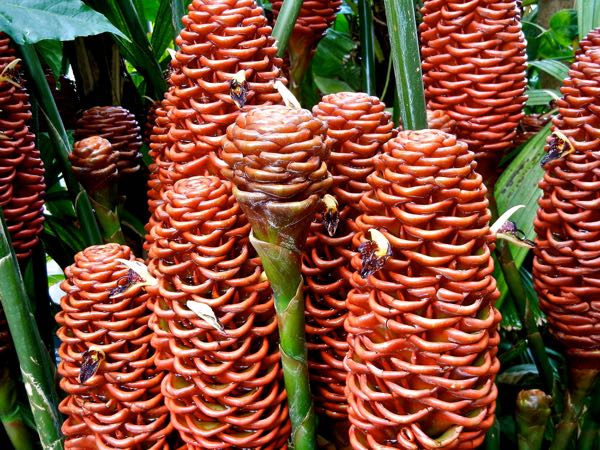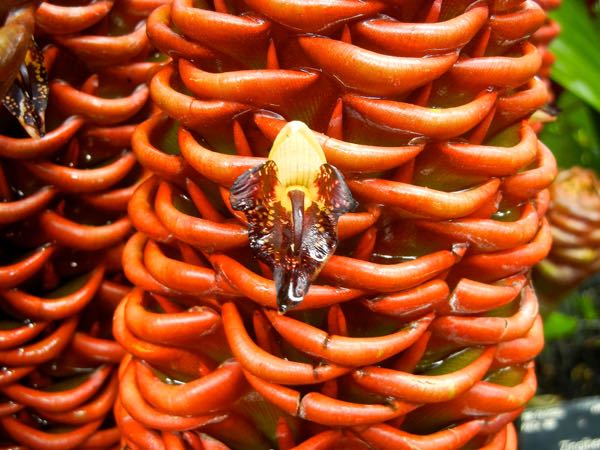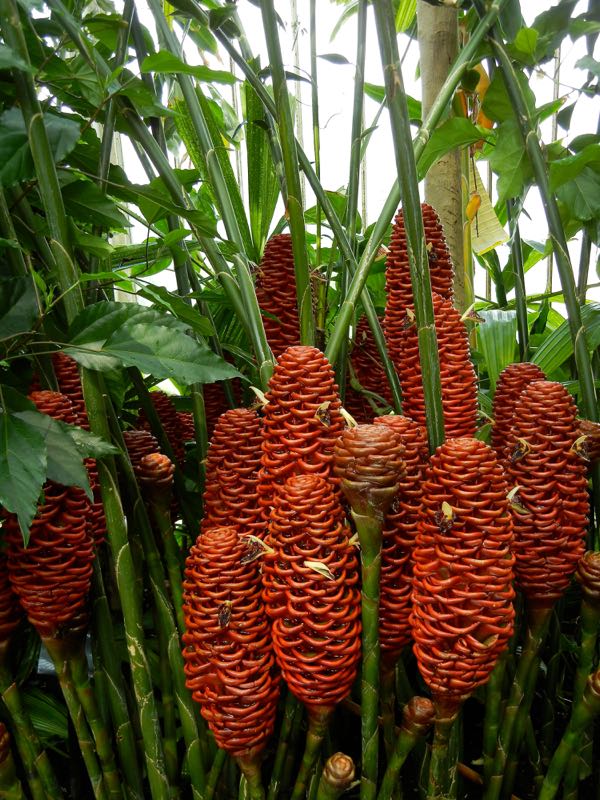Zingiber spectabile: The Beehive Ginger
Zingiber spectabile, also known as Beehive Ginger, is a captivating perennial plant that mesmerizes with its unique horn-shaped leaves and spectacular floral display. Belonging to the Zingiberaceae family, this remarkable species is native to Maritime Southeast Asia, including countries like Brunei, Indonesia, Malaysia, the Philippines, Singapore, and East Timor.
Appearance: The name “Zingiber” originates from Sanskrit, referring to the horn-like shape of the plant’s leaves. The species epithet “spectabile” derives from Latin, highlighting its spectacular nature. Beehive Ginger shares a botanical lineage with ginger plants, featuring rhizomatous growth and striking visual appeal. It boasts elongated, oblong leaves that gracefully taper to pointed tips, adding an elegant touch to its overall appearance.
Flowering and Bracts: During the blooming season, which typically occurs in summer, Zingiber spectabile unveils its true splendor. The plant showcases small, purple-colored flowers with vibrant yellow centers, nestled within bracts of various colors, ranging from white and yellow to dazzling orange. Resembling beehives or cones, these bracts create a visually captivating spectacle, attracting pollinators and human admirers alike.

How to grow Zingiber spectabile:
Cultivating Zingiber spectabile, commonly known as Beehive Ginger, requires providing the plant with suitable growing conditions that mimic its native habitat. By following these guidelines, you can ensure the healthy growth and vibrant blooms of this remarkable plant.
Light Requirements: Zingiber spectabile thrives in filtered sunlight or partial shade. While it appreciates bright light, direct exposure to intense sunlight for prolonged periods can lead to leaf scorching. It is best to position the plant in a location where it receives gentle morning or late afternoon sun while providing shade during the hottest parts of the day.
Soil and Moisture: Beehive Ginger prefers rich, well-draining soil that retains moisture without becoming waterlogged. A fertile soil mixture that is high in organic matter promotes healthy growth. Ensure that the soil remains consistently moist, but avoid overwatering, as excessive water can lead to root rot. Regularly check the soil moisture levels and water accordingly to maintain a moist but not saturated growing medium.
Humidity and Temperature: Creating a humid environment is crucial for the successful cultivation of Zingiber spectabile. This can be achieved by misting the foliage regularly or placing the plant on a tray filled with water and pebbles to increase humidity around it. The ideal temperature range for this plant is between 65°F and 75°F (18°C – 24°C). It is important to protect the plant from temperatures below 55°F (13°C), as it is not tolerant of cold conditions.
Propagation: Zingiber spectabile can be propagated through both seeds and division. Seeds can be sown in a well-draining potting mix and kept consistently moist until germination occurs. Division of the rhizomes is another effective method of propagation. When dividing the plant, ensure that each division has healthy shoots and roots for successful establishment.
Pruning: Regular pruning is not typically required for Zingiber spectabile. However, you can remove any old or damaged stems to maintain a neat appearance. Trim off spent flowers to redirect the plant’s energy into new growth and flower production.
Pest and Disease Control: Zingiber spectabile is generally a disease-free plant. However, it can be susceptible to infestations from red spider mites, particularly when grown in a greenhouse or indoor setting. Regularly inspect the plant for any signs of pests and take appropriate measures, such as using organic insecticidal soaps or introducing beneficial predators, to control their population.
Cultural Significance and Uses:
Apart from its captivating allure and ornamental value, Zingiber spectabile holds cultural significance and practical uses in its native regions. Locally, it is highly regarded for its flavorful contributions to culinary dishes, adding a distinctive zing to various recipes. Moreover, traditional medicine has embraced the plant’s healing properties, utilizing it to treat eye inflammation, burns, and headaches. In modern research, Zingiber spectabile has shown potential in tracing colon cancer, thanks to the presence of the Zerumbone synthase enzyme.
In conclusion, Zingiber spectabile, with its horn-shaped leaves, stunning floral displays, and diverse applications, stands as a remarkable addition to botanical enthusiasts, horticulturalists, and those seeking to explore the wonders of nature. Whether adorning tropical gardens, delighting taste buds, or contributing to traditional medicine, this enchanting species invites us to appreciate its beauty, cultural significance, and potential contributions to health and wellness.






If it is possible to send the seeds to China, I would like to buy some.
Unfortunately we don’t sell anything from this site. But you can check with sites that sell seeds and also check the customs information in China if they will be allowed in the country.